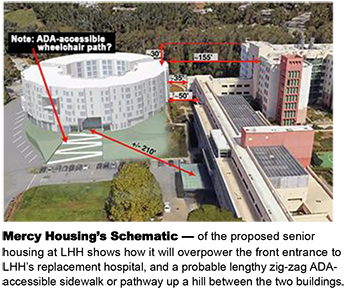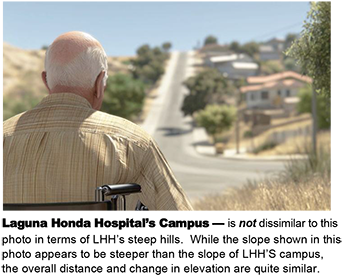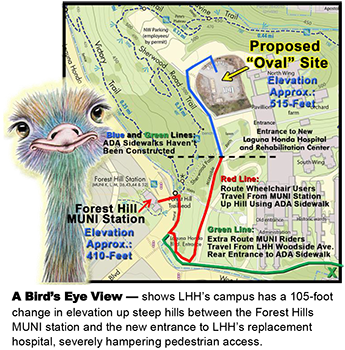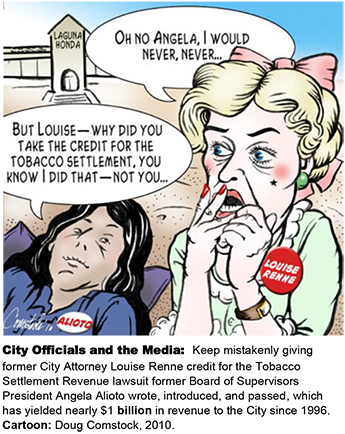 April 2, 2025
April 2, 2025Like Many Sequels, LHH’s Senior Housing Project Is Going to Be Worse
 April 2, 2025
April 2, 2025
Like Many Sequels, LHH’s Senior Housing Project Is Going to Be Worse
Laguna Honda Hospital Senior Housing Cut Again
Multiple Bait-and-Switches.
Promised 375 Housing Units for LHH May Deliver Only 124.
Federal HUD Funding Unlikely, Given San Francisco’s
“Sanctuary City” Policies
Being Singled out by President Donald Trump.
by Patrick Monette-Shaw
I didn’t realize that I, along with all San Franciscans, should be aware and remain vigilant to prevent our natural gas utility service from being “slammed” to another provider without our explicit consent.
 Just as Laguna Honda Hospital and Rehabilitation Center (LHH) lost 420 beds when it was downsized from its planned 1,200-bed re-build to just 780 beds in 2010 (a 35% change reduction), the proposed “senior housing” planned for LHH’s campus now appears to face downsizing from its proposed 375 units to now a more probable 124 units (a staggering 67% change loss of planned housing units).
Just as Laguna Honda Hospital and Rehabilitation Center (LHH) lost 420 beds when it was downsized from its planned 1,200-bed re-build to just 780 beds in 2010 (a 35% change reduction), the proposed “senior housing” planned for LHH’s campus now appears to face downsizing from its proposed 375 units to now a more probable 124 units (a staggering 67% change loss of planned housing units).
It’s the latest of several bait-and-switches that have befallen LHH, and an embarrassing sequel in downsizing.
To quell public outrage, the City is tossing in a childcare facility for 40 kids, now apparently reserved for employees of LHH and other City departments, despite former community outreach efforts to LHH’s surrounding neighborhoods that they might have access to the childcare, hoping to prevent neighborhood opposition to the proposed housing project.
The senior housing project for Laguna Honda Hospital’s campus is finally being resurrected, three years after the project was deep-sixed and placed on ice. The housing was sidetracked after LHH lost its Medicare and Medi-Cal reimbursement in April 2022 and the hospital was decertified, shuttering new patient admissions to the hospital. The housing project is picking up again, from where it was abandoned.
Readers may remember that when voters approved the November 5, 2019 “Affordable Housing Bond,” then District 7 Supervisor and Board of Supervisors Board President Norman Yee swore up and down the LHH senior housing project would bring desperately-needed licensed “Residential Care Facilities for the Elderly” (RCFE) capacity to San Francisco, specifically to LHH’s campus, after he managed to secure another $150 million for senior housing added to the $600 million bond.
Yee may have remembered that two decades earlier in November 1999, an “Assisted Living Facility” promised as part of the $400 million General Obligation Bond to rebuild Laguna Honda Hospital never received funding and was eliminated from the rebuild, but San Francisco’s Health Commission had supported identifying future funding for an eventual RCFE on LHH’s campus.
 Yee may have added the RCFE to lure voters into passing the $600 million “Affordable Housing Bond” in 2019, and to appease and win over the Health Commission. RCFE probably isn’t gonna’ happen, as it now turns out, and it may now be another bait-and-switch of the senior housing portion of the 2019 Bond.
Yee may have added the RCFE to lure voters into passing the $600 million “Affordable Housing Bond” in 2019, and to appease and win over the Health Commission. RCFE probably isn’t gonna’ happen, as it now turns out, and it may now be another bait-and-switch of the senior housing portion of the 2019 Bond.
In fact, the LHH housing project sequel has worsened. Again.
Shrinkage of LHH’s Promised Senior Housing
The shrinkage of LHH’s housing project size is alarming.
After voters passed the 2019 $600 million “Affordable Housing Bond,” the Mayor’s Office of Housing and Community Development (MOHCD) rather quickly issued a “Request for Proposals” (RFP) on November 18, 2019 for the senior housing component of the bond measure, that promised to build approximately 700 units of housing for the elderly citywide.
Mercy Housing’s response dated January 22, 2020 to MOHCD’s RFP stated on page 2 of Section 4-b, “Project Vision Narrative,” that Mercy was proposing to build up to 300 units of service-enriched low-income senior housing, with an even mix of studio and one-bedroom apartments, and at least 75 units of assisted living. Their hype it would build up to 375 senior housing units at LHH helped secure Mercy’s win to receive the contract award in June 2020.
By the time Mercy Housing issued its draft “Laguna Honda Senior Living Master Plan” in September 21, 2021 it showed on pages 47 and 48 that Mercy had reduced its promise of up to 375 housing units down to somewhere between 249 and 269 units. A loss of up to 124 units vanished after Mercy’s January 2020 response to MOHCD’s RFP secured the contract.
Mercy’s proposed construction site picked the part of LHH’s campus that had been intended for a third “Skilled Nursing Facility” (SNF) tower that was eliminated because of massive cost overruns of the LHH replacement hospital rebuild, stripping San Francisco of 420 of LHH’s former 1,200 SNF beds and forcing more elderly San Franciscans to be dumped into out-of-county facilities. That site, and large portions of LHH’s campus, is on the State of California’s “Cortese List” of toxic land sites having hazardous materials that haven’t been mitigated, as I reported in December 2021.
Supervisor Yee had only superficially engaged San Francisco’s Health Commission about his plans to place senior housing on LHH’s campus, zoned as “Public Land” for hospital facilities, not for residential development.
It took until March 3, 2022 before the Health Commissions “LHH Joint Conference Committee” (LHH-JCC) first received a formal presentation about the proposed housing for LHH’s campus. The presentation shocked the Health Commissioners, particularly Health Commissioner Edward Chow, who complained it had taken Supervisor Yee so long to even consult the Health Commission formally. MOHCD’s March 2022 presentation to the LHH-JCC did another bait-and-switch, claiming the project would include “supportive senior housing,” not a licensed RCFE, and asserted again that up to 170 independent senior living apartments plus 95 RCFE “assisted living” units would be built, for a total of 265 units.
But MOHCD, Supervisor Yee, and then-Mayor London Breed weren’t prepared for LHH’s sudden decertification on April 14, 2022. The decertification caused LHH’s senior housing project to be rapidly placed on ice, where it remained for three years until February 3, 2025 — even though LHH had gained full recertification on June 2024.
 Resurrected Housing Scaled Back
Resurrected Housing Scaled Back
On February 3, 2025 the LHH-JCC received a 23-page presentation from MOHCD on the status of resurrecting the affordable housing project on LHH’s campus. The February 3 presentation indicated that somewhere between 130 and 170 independent living apartment units would be built for “seniors” during Phase 1, plus potentially 90 assisted living units in a licensed RCFE or “enhanced supporting services” in highly supportive housing during Phase 2 — for a total of 220 to potentially 260 units.
During the February 3 presentation to the LHH-JCC, Tim Dunn, an Associate Director at Mercy Housing, admitted in response to Health Commissioners questions during the meeting that the childcare facility “will be for LHH’s workforce,” perhaps admitting for the first time that assurances made to homeowners who are neighbors surrounding LHH’s campus during community outreach meetings between 2020 and 2022 that they might be eligible to access the childcare services on LHH’s campus. The neighbors may have been deliberately misled.
Those neighborhood associations included the Greater West Portal Neighborhood Association, Midtown Terrace Homeowners Association, Forest Hill Association, the Woods Condo Association and perhaps other neighborhood associations.
 Then on March 17, 2025 MOHCD made another 31-page presentation to the full Health Commission with additional details of the planned housing for LHH’s campus.
Then on March 17, 2025 MOHCD made another 31-page presentation to the full Health Commission with additional details of the planned housing for LHH’s campus.
Before Mercy made its formal presentation on March 17, introductory comments were made by former District 7 Supervisor Norman Yee, current D-7 Supervisor Myrna Melgar, former City Attorney Louise Renne, and Anthony Wagner, LHH’s former Executive Administrator until 1988.
Yee noted during his remarks that assisted living facilities have conspicuously been disappearing in San Francisco, leading to placing seniors in out-of-county facilities. Yee noted LHH needs the senior housing to assist with temporarily placing patients ready for discharge from the hospital into housing, and the childcare center would benefit LHH staff and help meet the needs of families living nearby LHH, and LHH has an animal “petting zoo” that makes LHH campus an ideal site for senior housing. Yee mistakenly called it the 2018 Affordable Housing Bond (the Bond passed in 2019), and he asserted he had met with neighbors in 2017 and 2018, when MOHCD’s records show Yee’s outreach to neighbors was between 2020 and 2022.
It’s not known why Yee believes the project might only temporarily house patients ready for hospital discharge for short periods of time. All along we’ve been told it’s supposed to be permanent housing opportunities.
 For her part, Supervisor Melgar asserted the senior housing project will help LHH’s patient census by providing “step-down” units for patients being discharged close to LHH’s skilled nursing staff, and the childcare will help City employees in other City departments. The senior housing has always been planned for long-term, affordable rental to seniors, not as temporary “step-down units.” Where Melgar got the impression of step-down units from isn’t known, either (unless it’s something voters haven’t been told about yet).
For her part, Supervisor Melgar asserted the senior housing project will help LHH’s patient census by providing “step-down” units for patients being discharged close to LHH’s skilled nursing staff, and the childcare will help City employees in other City departments. The senior housing has always been planned for long-term, affordable rental to seniors, not as temporary “step-down units.” Where Melgar got the impression of step-down units from isn’t known, either (unless it’s something voters haven’t been told about yet).
During her turn at the microphone, Louise Renne, 87, claimed that during her tenure as City Attorney “we won” the tobacco lawsuit used in part to fund the 2010 LHH rebuild project, but “we” had to eliminate the assisted living and Adult Day Health Care components from the rebuild project. That’s why those two components are being added to funding from the senior housing project. Renne asserted the childcare facility would be a benefit for recruiting LHH staff. Renne bizarrely (and mistakenly) stated on the March 17 hearing video that “We had to terminate the assisted living [units] that we had at the time at LHH.”
On March 29, 2025 a San Francisco Chronicle article also attributed Renne as having said “Laguna Honda Hospital once had assisted living housing on site, but those units were demolished when the old hospital was torn down in the early 2000’s.” Renne’s recollections are confused that LHH’s Clarendon Hall building that largely treated patients with various forms of dementia’s and was eventually torn down, was an “assisted living” facility. Clarendon Hall was not. It housed Laguna Honda patients. LHH has never had any assisted living units.
 [Note: Renee didn’t mention on March 17 she had been directed in 1996 by then-Mayor, Willie L. Brown, to try to stop former Board of Supervisors president Angela Alioto from passing Board Resolution #469-96 with unanimous Board approval to file the lawsuit against “Big Tobacco,” nor did Renne mention that Mayor Brown and Renne outsourced the lawsuit to the law firm Lieff Cabraser Heimann & Bernstein, LLP to prosecute for San Francisco, along with other cities and counties in California. Renne’s nebulous “we” did not win that lawsuit. Renne just likes to keep taking misplaced credit for Angela Alioto’s legal strategy! See below.]
[Note: Renee didn’t mention on March 17 she had been directed in 1996 by then-Mayor, Willie L. Brown, to try to stop former Board of Supervisors president Angela Alioto from passing Board Resolution #469-96 with unanimous Board approval to file the lawsuit against “Big Tobacco,” nor did Renne mention that Mayor Brown and Renne outsourced the lawsuit to the law firm Lieff Cabraser Heimann & Bernstein, LLP to prosecute for San Francisco, along with other cities and counties in California. Renne’s nebulous “we” did not win that lawsuit. Renne just likes to keep taking misplaced credit for Angela Alioto’s legal strategy! See below.]
Then, MOHCD’s Senior Project Manager, Anne Romero, presented Mercy’s update to the full Health Commission. Among other things, Romero asserted it will be possible for LHH to make referrals for the affordable housing units for LHH patients ready for discharge from the hospital. Romero reiterated Mercy had been chosen for its experience incorporating childcare facilities, and ADHC programming into Mercy’s senior housing project portfolio.
 Romero indicated that the Phase 1 senior unihousingts and the Phase 2 assisted living units will be placed in separate sub-divided parcels of LHH’s campus that will later require the Health Commission to approve separate jurisdictional transfers of the two subdivided parcels from the San Francisco Department of Public Health to MOHCD control, and will then need Board of Supervisors approval to do so.
Romero indicated that the Phase 1 senior unihousingts and the Phase 2 assisted living units will be placed in separate sub-divided parcels of LHH’s campus that will later require the Health Commission to approve separate jurisdictional transfers of the two subdivided parcels from the San Francisco Department of Public Health to MOHCD control, and will then need Board of Supervisors approval to do so.
Romero stated the assisted living component in Phase will most likely not be a licensed RCFA, as the Health Commission had wanted as far back as 2007 and which Supervisor Yee had strongly requested. Romero, for good measure, repeated that LHH employees will be given preference for the childcare programming (not neighbors).
Details in the presentation show that in the month between MOHCD’s two presentations to the Health Commission on February 3 and March 17 the total amount of housing was downsized again from 220 to 260 units to only 214 units, another bait-and-switch loss of 46 more units — reducing the 130 to 170 independent living units to just 124 one-bedroom apartments, rather than a mix of studios and one-bedrooms, plus the 90 RCFE or assisted living units.
 And although the February 3 presentation asserted Mercy would pursue a licensed RCFE for the assisted living units in Phase 2, by March 17 Mercy changed that to providing 90 housing units with “enhanced supportive services” that might “approach a similar level of service as a licensed RCFE to accept discharged residents from LHH,” another bait-and-switch.
And although the February 3 presentation asserted Mercy would pursue a licensed RCFE for the assisted living units in Phase 2, by March 17 Mercy changed that to providing 90 housing units with “enhanced supportive services” that might “approach a similar level of service as a licensed RCFE to accept discharged residents from LHH,” another bait-and-switch.
Assisted living in Phase 2 was changed between February 3 and March 17 from senior housing to housing for “older adults with chronic health and long-term-care needs.” And suddenly, the assisted living was changed to being a conduit for speeding up hard-to-place LHH residents. It was essentially another bait-and-switch in terminology from “senior housing” in Phase I to “older adults” in Phase 2, which portends a potential change of the demographics of who will be eligible for placement in the assisted living apartments to support “older adults” who may not actually be “senior citizens” yet.
Again during the March 17 presentation, MOHCD stressed the importance of prioritizing the childcare programming for inclusion as part of Phase 1, and delaying the “Adult Day Health Care” facility to Phase II. That’s also outrageous, in part because ADHC programming for both outpatients and select LHH residents formerly operated  in the old LHH facility prior to the hospital’s 2010 rebuild, had been abruptly shown down 17 years ago in approximately 2008 in anticipation of construction starting on the replacement hospital. For patient safety, LHH didn’t want busloads of outpatients with dementia’s coming to LHH’s campus during the three-year hospital rebuild construction project.
in the old LHH facility prior to the hospital’s 2010 rebuild, had been abruptly shown down 17 years ago in approximately 2008 in anticipation of construction starting on the replacement hospital. For patient safety, LHH didn’t want busloads of outpatients with dementia’s coming to LHH’s campus during the three-year hospital rebuild construction project.
I worked at LHH in 2008 when the ADHC programming was sadly and abruptly shut down. A then-Associate Hospital Administrator, Gayling Gee, was forced to resign, because she had used her first amendment rights on her own time as a private citizen — not speaking in her role as a senior LHH employee — when she testified before the Health Commission urging them to retain the ADHC programming in the old hospital and to make sure ADHC programming would be offered when the replacement hospital was completed and opened in 2010. Ms. Gee had been a highly respected and beloved LHH employee as a registered nurse, but she was kicked almost literally overnight for advocating for patients, apparently with the Health Commission’s consent she be terminated. Dr. Chow should have been ashamed Gee was forced out!
 The ADHC programming was not reinstated when the replacement hospital opened in 2010, principally because no space had been designed for it in the architectural drawings for the new hospital, a conscious fiscal choice driven by massive cost overruns.
The ADHC programming was not reinstated when the replacement hospital opened in 2010, principally because no space had been designed for it in the architectural drawings for the new hospital, a conscious fiscal choice driven by massive cost overruns.
The sequel delaying ADHC programming to Phase II — which may never be built at all — is shameful, primarily because an ADHC is needed now, much more than a childcare facility.
When the March 17 presentation was opened for Health Commissioner questions, Commissioner Chow indicated he wants additional information on what percentage of, and which, LHH’s residents will be eligible for placement in either LHH’s independent living or assisted living housing projects. Chow indicated he’s concerned President Trump’s proposed tariffs might impact building construction costs of the housing projects — including 25% tariff’s on lumber and steel.
Chow also seemed to be distressed that the assisted living or RCFE project is being pushed back. That is probably because Chow was a member of the Health Commission when it passed Resolution #16-07 in 2007 recommending an assisted living RCFE be built on LHH’s campus. And Chow seemed to remain concerned that the housing projects may still be placed too closely to, and overpower, the Pavilion Building’s entrance to LHH’s new main hospital.
 Probable Funding Threats
Probable Funding Threats
Of note, the March 17 presentation reported that both the Phase I independent living apartments and the Phase II assisted living units currently rely on obtaining Low Income Housing Tax Credit (LIHTC) Equity, and federal Housing and Urban Development (HUD) Section 202 Supportive Housing for the Elderly General Partner Equity that provides capital advances and project-based rental assistance to support the creation and maintenance of affordable housing for very low-income elderly individuals.
Funding for Phase II is also premised on receiving a HUD/FHA 232 loan. The Phase II assisted living will also need “Assisted Living Waivers” from the State of California — which are in extremely short supply — along with PACE funding, and assistance from San Francisco’s “Community Living Fund (CLF).” The CLF and its leaders dislike Laguna Honda Hospital intensely, so it’s unlikely CLF funding will materialize.
Between February and May 2015, Elon Musk’s DOGE and his co-sidekick president Donald J. Trump have taken their chainsaws to HUD. Initial reports showed plans to eliminate half of HUD’s field offices and cut HUD’s workforce by 50%. In addition, the San Francisco Public Press published an article on April 9 regarding the  Trump administration’s threats to cancel HUD grants to San Francisco over our City’s “sanctuary city” policies, including HUD’s Section 202 direct loan program that MOHCD is relying on for both phases of LHH’s senior housing and assisted living project, along with HUD’s Section 8 housing vouchers and other HUD supportive housing funding streams.
Trump administration’s threats to cancel HUD grants to San Francisco over our City’s “sanctuary city” policies, including HUD’s Section 202 direct loan program that MOHCD is relying on for both phases of LHH’s senior housing and assisted living project, along with HUD’s Section 8 housing vouchers and other HUD supportive housing funding streams.
It’s extremely unlikely MOHCD and Mercy Housing will secure HUD funding for LHH’s senior housing components, given Trump’s hatred of California ingeneral, and San Francisco in particular. After all, Trump’s tariff’s and trade war may lead to massive cost overruns on LHH’s senior housing projects, as a sequel to the 2010 enormous cost overruns on the hospital replacement project.
Mercy’s March 17 presentation reported that the earliest start of construction for the Phase I independent senior housing is two years from now in the Spring of 2027. But that came with a huge caveat: “Pending successful state, tax credit and bond financing applications.” Mercy anticipates the earliest date of completion of Phase I would be sometime in 2029 — fully a decade after passage of the 2019 Affordable Housing Bond. Funds for the LHH housing should have been re-allocated to another affordable housing project years ago, since the City has the flexibility to reallocate funds from, or within, housing bonds to other eligible affordable housing projects. It shouldn’t take a decade, or longer, to bring a housing project  online!
online!
And Mercy’s presentation noted that the earliest start of construction for the Phase II assisted living units would also be in 2029, with at least a two-year construction period extending into 2031. But Mercy’s presentation also acknowledged that while Phase II may still be feasible, the current anticipated funding sources are very competitive, so “Phase II could be delivered and placed in service at a later date than currently anticipated.”
When the March 17 presentation was opened for questions from the Health Commissioners, none of the Health Commissioners asked any questions about the HUD Section 202 funding, and they asked not one question about whether the assisted living RCFE units might be delayed well past 2029, or into 2031. That may have been, in part, because MOHCD had not initially presented the Health Commission the accompanying detailed Appendices with the relevant information prior to MOHCD’s March 17 presentation, until I raised questions about, and independently obtained, the Appendices directly from MOHCD.
 Different Than Requested
Different Than Requested
We now know that rather than the type of assisted living initially envisioned back in 2007, the bait-and-switch presented to the Health Commission on March 17, 2025 is completely different.
Just as construction of LHH’s replacement facility was getting underway18 years ago, the full San Francisco Health Commission adopted Resolution #16-07 during its of December 4, 2007 meeting that accepted the “Laguna Honda Hospital and Rehabilitation Center Assisted Living Feasibility Study.”
That feasibility study recommended that “the City expand its continuum of care on the Laguna Honda campus by constructing an assisted living facility that would have a total potential capacity of 240 residents, in buildings that meet the standards for a Residential Care Facility for the Elderly-Type II, and that the buildings  should be constructed as [soon as] financing becomes available.”
should be constructed as [soon as] financing becomes available.”
The Health Commission had made it clear in 2007 that it preferred having a licensed RCFE built on LHH’s campus to expand the continuum of care for the elderly. The Commission had not wanted just independent living apartments and a childcare facility “as soon as funding became available,” it had wanted a desperately needed RCFE, perhaps with an outpatient Adult Day Health Care (ADHC) programming component.
Campus Inappropriate for Senior Housing
I outlined a plethora of reasons LHH’s campus is the wrong location, in “Laguna Honda: Inappropriate Site for Housing” on October 5, 2020 — in part because an ADA-accessible sidewalk up LHH’s steep hills doesn’t reach the proposed housing site.
Given LHH’s steep and variable topography and elevation, it doesn’t seem to have ever occurred to anyone, including former Supervisor Yee and now Supervisor Melgar, whether the elderly they want to housing create for on LHH’s campus can comfortably walk more than one block up LHH’s very steep hills, since the distance is four or more blocks away — and probably over a quarter of a mile, all uphill — from the Forest Hill MUNIstation! LHH’s campus isn’t walk-friendly for the elderly and disabled.
 LHH’s October 1994 “Master Plan” clearly states on pages 2 and 3:
LHH’s October 1994 “Master Plan” clearly states on pages 2 and 3:
“[LHH’s] 62 acre Campus is located high on a hill … but is tempered by the steeply sloping topography which limits circulation and access. Intracampus pedestrian and wheelchair movements are particularly difficult.”
and
“Pedestrian access to the Hospital from the rapid transit station and street is severely hampered by the 100 foot change in elevation between the Hospital entry and the street.”
A San Francisco Department of Public Health 2014 transit analysis revealed over 30% of Potrero Hill Health Center (PHHC) patients cannot comfortably walk more than one block up a steep hill, 85% had at least one symptom impacting their ability to walk, and 26% reported using at least one assistive device (cane, walker, wheelchair, etc.). The PHHC is a safety-net clinic serving primarily low-income patients, the same type of seniors planned for LHH’s housing projects.
 In addition, other issues include:
In addition, other issues include:
Lack of Neighborhood-Serving Retail
There’s absolutely no neighborhood-serving retail within a two-block radius of the LHH’s campus, or even an eight-block radius. There are no retail shops anywhere close to the campus. The two or three restaurants at the bottom of the hill near the campus typically close early each evening — assuming they’re still in business after COVID.
The closest grocery store and pharmacy — Mollie Stone’s and CVS — are on Portola Drive, at least an eight-block walk up steep hills, and difficult to access by public transportation.
It’s not as if neighborhood-serving retail is going to come to the area any time soon, or ever, since LHH’s campus is surrounded by an enclave of single-family homes.
 Inadequate Public Transportation
Inadequate Public Transportation
It’s unclear if MOHCD had concerns about the lack of transportation when it turned Yee down the first time in 2018 when he proposed housing at LHH, and it’s also unclear whether public transportation has been studied fully before building housing on LHH’s campus.
LHH operates and funds a wheelchair accessible shuttle bus using hospital employee labor to provide transportation for patients, employees, and visitors between the  Forest Hill MUNI Station and the hospital’s main entrance in its new Pavilion building. It costs LHH approximately $300,000 annually.
Forest Hill MUNI Station and the hospital’s main entrance in its new Pavilion building. It costs LHH approximately $300,000 annually.
But it only operates every 15 minutes between 6:00 a.m. and 10:00 a.m., and then every 20 minutes between 10:00 a.m. and 5:50 p.m., leaving visitors, residents, and employees without a shuttle service. The last shuttle bus leaves Forest Hill Station at 5:35 p.m., essentially ending service just before 6:00 p.m. on its last trip to LHH’s campus. Worse, it only operates weekdays (Monday through Friday), essentially eliminating public transportation to LHH’s campus in the evening hours all week, with no shuttle bus service at all on weekends! People living in the senior housing would have no transportation to and from LHH’s campus all weekend long!
For her part, Supervisor Melgar secured funding to launch a multi-year study on whether to improve transportation between the Forest Hill MUNI station and LHH’s campus by constructing an overhead tram or gondola system up the steep hill to the hospital. While the feasibility study for a gondola system hasn’t begun yet, it’s easy to imagine a gondola system could easily run $10 million to $20 million, if not more, with no idea of how often the gondolas would run, and whether they would operate in the evenings and on weekends on the fog-laden campus.
My October 2020 article outlined many additional reasons LHH is an inappropriate location.
As well, the illustration of Mercy’s proposed housing at the top of this article reveals what appears to be another tortuous six change-in-direction zig-zag along an  ADA-accessible wheelchair path that will need to be constructed between the new entrance to LHH’s main hospital, up another hill to where the housing will be built. It will be another burden on seniors who use wheelchairs or have mobility problems walking.
ADA-accessible wheelchair path that will need to be constructed between the new entrance to LHH’s main hospital, up another hill to where the housing will be built. It will be another burden on seniors who use wheelchairs or have mobility problems walking.
Continued Myth Making
During the past 15 years, I’ve tried to do my part to counter mythmaking by San Francisco public officials and Ms. Renne who claims it was she who “won” San Francisco’s lawsuit against four of the Big Tabacco companies, earning San Francisco $1 billion in tobacco settlement revenues.
On July 4, 2010, I published an opinion piece on the then San Francisco Examiner web site noting that speaker after speaker during LHH’s grand opening ribbon-cutting ceremony on June 26, 2010 mistakenly credited Renne for the tobacco lawsuit idea. Speakers included then-Mayor Gavin Newsom, then District 7 Supervisor Sean Elsbernd, then Congresswoman Jackie Speier, and other  politicians. Each speaker who credited Renne for initiating the tobacco settlement lawsuit engaged in myth-telling.
politicians. Each speaker who credited Renne for initiating the tobacco settlement lawsuit engaged in myth-telling.
My article tried to set the record straight that it had been former Board of Supervisors Angela Alioto who had developed a novel legal strategy in 1996, using a cause of action to sue tobacco companies as an employer of consumers, to get around California consumer product liability lawsuits against tobacco manufacturers, a California law authored by then State Assemblyman Willie L. Brown preventing Californians from suing tobacco companies for harms caused to consumers. By then, Brown had become mayor of San Francisco.
My July 2010 article was accompanied by a three-page slideshow featuring Alioto’s book jacket to her 1997 memoir, “Straight to the Heart: Political Cantos.” The slideshow included select quotes from Alioto’s book, noting that she had authored Board Resolution 469-96, instructing the City Attorney to sue the tobacco industry and outlining explicitly how Renne should implement the lawsuit.
Alioto’s book recounts on pages 219 to 220 that five minutes before the scheduled vote, Renne waltzed in, demanded an immediate closed-door private session with the Board, claimed the City didn’t have $1 million to file the lawsuit, and that the Board would have to come up with a million dollars from the City budget before Alioto’s Resolution could be passed. Three Supervisors were outraged at Renne’s transparent attempt to quash the legislation. Board President Kevin Shelley called it “sabotage.” The Supervisors returned to Board chambers and passed the legislation without a single no vote.
Mayor Brown and Renne chose to outsource prosecution of the tobacco lawsuit to a private law firm, to “save face” for Brown. This myth Renne “won” the lawsuit will hopefully die some day.
Health Commission Should Just Say “No”
In theory, this would now be about the time that the Health Commission exercises its oversight authority as LHH’s “ governing body,” and reject Mercy’s proposed project, by just saying “No”! In practice, it’s unlikely the Health Commission will do anything. San Franciscans will be stuck with an affordable senior housing project at LHH that is a completely inappropriate project to meet the needs of the elderly. This sequel will probably continue to worsen.
governing body,” and reject Mercy’s proposed project, by just saying “No”! In practice, it’s unlikely the Health Commission will do anything. San Franciscans will be stuck with an affordable senior housing project at LHH that is a completely inappropriate project to meet the needs of the elderly. This sequel will probably continue to worsen.
Also of interest, between MOHCD’s June 2024 and December 2024 “2019 Bond Status” reports, a new category of senior housing has been added to provide 100 affordable housing units reserved for behavioral health seniors, being placed out on isolated Treasure Island. Voters weren’t told six years ago in 2019 that the Bond would be funding housing for behavioral health patients, so this is yet another bait-and-switch.
The six-story project, titled “Treasure Island E1.2” is also being developed by Mercy Housing Corporation. It will be placed adjacent to a San Francisco Department of Public Health behavioral health project under development on Treasure Island. A “Request for Predevelopment Financing” for the project was presented to the Citywide Affordable Housing Loan Committee in January 2023. It will reportedly receive a $2.7 million “gap loan” in the Spring of 2026, probably as predevelopment funding from the senior housing portion of the 2019 Affordable Housing Bond.
 Why was this added to the Bond spending — five years after the Bond was passed in 2019?
Why was this added to the Bond spending — five years after the Bond was passed in 2019?
The Health Commission should simply connect the dots and transfer this badly needed senior housing project off of LHH’s campus and place it somewhere else in the City, and just say “No” to former Supervisor Norman Yee and MOHCD, because it’s an inappropriate site for senior housing.


Monette-Shaw is a columnist for San Francisco’s Westside Observer newspaper, and a member of the California First Amendment Coalition (FAC) and the ACLU. He operates stopLHHdownsize.com. Contact him at monette-shaw@westsideobserver.com.